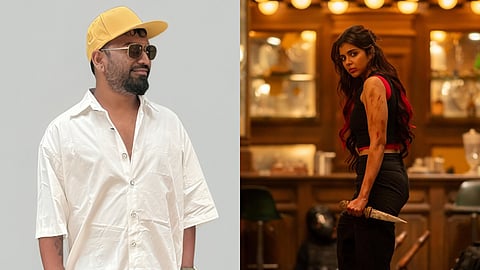Lokah production designer Banglan: If money is spent, it has to be visible in the frame
Step into Dominic Arun's Lokah Chapter 1: Chandra, and you find yourself wandering through streets that gleam with neon, caves that whisper secrets, and apartments that carry the tension of a city on edge. None of it feels out of place, yet none of it feels entirely real. That balance between the familiar and the uncanny is the signature of Banglan.
The National Award-winning production designer has built his reputation on turning constraints into wonder. In Lokah, Kerala’s landscapes take on a second life, reshaped into a superhero universe drawn from local folklore that reflects the pulse of Bengaluru in a new light. For Banglan, production design is never about ornament, but about narrative, where texture and colour speak as powerfully as dialogue.
As Lokah continues its remarkable run at the global box office, having recently crossed the 200 crore mark and now inching towards potentially becoming the highest-grossing Malayalam film ever, Banglan pauses to reflect on how this world was pieced together. Between conversations on precision, trust, and invention, he is also already navigating other giants on his slate, from Kantara: A Legend Chapter 1, due for release in October, to Suriya 46 with his Lucky Baskhar collaborators.
Excerpts:
Can you walk us through how you first became involved with Lokah?
I first worked with the same core team on Oblivion, a music video. Some elements from that, like the way the hospital was set up, were also carried over while creating the world of Lokah. Nimish (Ravi) was the first to tell me about this film, saying it was a good story. At first, I was not sure if I would be able to commit because I was already tied up with Lucky Baskhar, Kantara: A Legend Chapter 1, and Maareesan. But I managed to find the time and space, and agreed to be part of Lokah. Later, Dominic came down to Hyderabad during the shoot of Lucky Baskhar and narrated the story to me, and soon after, I began working on the pre-production.
What was Dominic Arun’s initial brief to you?
After narrating the story, he was clear that it should have a neon, cyberpunk palette while portraying a metropolitan city like Bengaluru in a different way than what we usually see. Dominic and I are also big fans of Wong Kar-wai films, so that influenced us as well. We adapted the tones according to our story. It is definitely a dark world, but with contrasting colours to complement it. In the end, it is all about choosing the right colour for what a particular scene needs at that moment.
How did you ensure this world didn’t just look stylish but also felt consistent throughout?
Every frame was pre-designed, from the colours to the details of the costumes. Once approved by the director, there were no changes. Even Chandra’s knife was designed with detailed precision. It was about maintaining discipline in execution, so the world would feel uniform on screen.
What was the thinking behind recreating Bengaluru across multiple locations in Kerala?
If you want to shoot a metro city realistically, you could just film it there. But we had a certain plan, design, and mood for the setting, and we wanted to bring that while portraying a city like Bengaluru. A few portions were shot in Bengaluru for detailing, but most of the other exterior scenes were filmed in controlled settings that we recreated. It was not about building an entirely new set, but about adapting existing locations to show what we wanted on screen.
I always try not to use the entire budget on sets, but instead to find original locations whenever possible, because our industry has financial limits. For example, the cave shown in Lokah is a real cave in Kannur, but the version seen in the film is dressed up differently with added details such as ancient-looking inscriptions, a mist-like spray of water, natural tree roots, and greenery using plants.
Let’s talk about specific spaces. How did you approach the Holy Grail Cafe?
We wanted something like a Hard Rock Cafe in Bengaluru, but it was not practical to change the details in the actual location. So we found a spot in Kochi where it could be convincingly recreated. We first prepared a floor plan, then reshaped the church slightly, added stones, and transformed it into a modern cafe.
And what went into creating Chandra and Sunny’s opposite-facing apartments?
The exterior portions outside their apartments were shot on real streets in Bengaluru, while the interiors were created on sets in Kochi. The idea of the hero and heroine living in opposite apartments was a reference Dominic took from the film Vandanam. For the street scenes, we used neon boards, practical lights and glass reflections. The neon boards and lighting added an extra charm to the visuals while also creating the feel of a metro city.
What about Moothon’s space and the larger set pieces?
If you look at Hollywood productions, they would probably build entire grand sets to shoot such spaces. But with our constraints, we marked the frame and added only what was required to bring in that sense of grandeur within a confined space, even if it looks huge on screen.
Even the portions featuring Dulquer were shot on sets created on the floor in Kochi. The same approach was used for the opening stretch set in Sweden, which was again recreated in Kochi.
We had the whole film pre-visualised as a 3D animation before shooting, so there was no confusion during execution for any of the departments involved. It helped us save both cost and time.
How did you design the forest sequences that depict Chandra’s origin with a fairytale quality?
It was shot in Athirappilly forest. While designing that stretch, we locked onto a landmark that would connect the past and present, which was the tree and temple you see both in the flashback set in the forest and in the present-day metro city.
There is also a river in that forest stretch, and naturally, when that space is transformed into a city with buildings, the traces of that river should remain in the present as well.
Both Lokah and Kantara: A Legend Chapter 1 were in production at the same time. How did you manage that balancing act?
When Lokah started, I was not on set for the entire shoot. Once the design of a particular stretch was locked, I would return to the sets of Kantara. My art director, who was fully present on the sets of Lokah, kept sending me visuals from the monitor from time to time to cross-check that everything was in place as planned. If anything needed to be added or changed, the respective departments could be alerted straight away, and it would be sorted.
Do you see the success of Lokah as a turning point for Malayalam cinema?
Of course. I am delighted that a female-led film from Malayalam could achieve such huge success with audiences who are familiar with the kind of films Marvel is making. Viewers across languages embraced it. This is a ray of hope for upcoming producers and directors, showing that investing in strong content brings results.
For a film of this scale, trust is essential, and Dulquer had that in us. Without him, this film could not have been made so well. He had no doubts or anxiety about whether the budget might rise or fall, and that trust gave us complete support at every stage.
Also, it is not enough for the sets to look good; the film itself has to be strong. If money is spent, it has to be visible in the frame. From beginning to end, the audience can see that quality in Lokah. In some other industries, 80 per cent of the budget often goes into actors’ salaries. Here, more is spent on making, and every penny spent is visible in the frames. We are able to complete films within the quoted budget, which is not always the case elsewhere.
Have you started work on the next instalment of Lokah?
Dominic and Nimish have already started. Dominic has the entire storyline mapped out for all the instalments, but the screenplay still needs to be completed. Once that is finalised, I will step in.
In the meantime, I have equally big commitments, such as Venki Atluri’s film with Suriya, which I am currently working on. In Telugu, I have also committed to a project with Trivikram sir, as well as a period drama by Ashwin Gangaraju starring Rishab Shetty.
In Tamil, I am part of Kamal Haasan sir's film directed by Anbariv. And in Malayalam, there is Prithviraj’s Kaaliyan, which should begin either at the end of this year or early next year. I have also completed Prithviraj’s Vilayath Buddha, which is now in post-production.

